Shaoan Xie
Step-Aware Policy Optimization for Reasoning in Diffusion Large Language Models
Oct 02, 2025Abstract:Diffusion language models (dLLMs) offer a promising, non-autoregressive paradigm for text generation, yet training them for complex reasoning remains a key challenge. Current reinforcement learning approaches often rely on sparse, outcome-based rewards, which can reinforce flawed reasoning paths that lead to coincidentally correct answers. We argue that this stems from a fundamental mismatch with the natural structure of reasoning. We first propose a theoretical framework that formalizes complex problem solving as a hierarchical selection process, where an intractable global constraint is decomposed into a series of simpler, localized logical steps. This framework provides a principled foundation for algorithm design, including theoretical insights into the identifiability of this latent reasoning structure. Motivated by this theory, we identify unstructured refinement -- a failure mode where a model's iterative steps do not contribute meaningfully to the solution -- as a core deficiency in existing methods. We then introduce Step-Aware Policy Optimization (SAPO), a novel RL algorithm that aligns the dLLM's denoising process with the latent reasoning hierarchy. By using a process-based reward function that encourages incremental progress, SAPO guides the model to learn structured, coherent reasoning paths. Our empirical results show that this principled approach significantly improves performance on challenging reasoning benchmarks and enhances the interpretability of the generation process.
SmartCLIP: Modular Vision-language Alignment with Identification Guarantees
Jul 29, 2025Abstract:Contrastive Language-Image Pre-training (CLIP)~\citep{radford2021learning} has emerged as a pivotal model in computer vision and multimodal learning, achieving state-of-the-art performance at aligning visual and textual representations through contrastive learning. However, CLIP struggles with potential information misalignment in many image-text datasets and suffers from entangled representation. On the one hand, short captions for a single image in datasets like MSCOCO may describe disjoint regions in the image, leaving the model uncertain about which visual features to retain or disregard. On the other hand, directly aligning long captions with images can lead to the retention of entangled details, preventing the model from learning disentangled, atomic concepts -- ultimately limiting its generalization on certain downstream tasks involving short prompts. In this paper, we establish theoretical conditions that enable flexible alignment between textual and visual representations across varying levels of granularity. Specifically, our framework ensures that a model can not only \emph{preserve} cross-modal semantic information in its entirety but also \emph{disentangle} visual representations to capture fine-grained textual concepts. Building on this foundation, we introduce \ours, a novel approach that identifies and aligns the most relevant visual and textual representations in a modular manner. Superior performance across various tasks demonstrates its capability to handle information misalignment and supports our identification theory. The code is available at https://github.com/Mid-Push/SmartCLIP.
Controllable Video Generation with Provable Disentanglement
Feb 04, 2025



Abstract:Controllable video generation remains a significant challenge, despite recent advances in generating high-quality and consistent videos. Most existing methods for controlling video generation treat the video as a whole, neglecting intricate fine-grained spatiotemporal relationships, which limits both control precision and efficiency. In this paper, we propose Controllable Video Generative Adversarial Networks (CoVoGAN) to disentangle the video concepts, thus facilitating efficient and independent control over individual concepts. Specifically, following the minimal change principle, we first disentangle static and dynamic latent variables. We then leverage the sufficient change property to achieve component-wise identifiability of dynamic latent variables, enabling independent control over motion and identity. To establish the theoretical foundation, we provide a rigorous analysis demonstrating the identifiability of our approach. Building on these theoretical insights, we design a Temporal Transition Module to disentangle latent dynamics. To enforce the minimal change principle and sufficient change property, we minimize the dimensionality of latent dynamic variables and impose temporal conditional independence. To validate our approach, we integrate this module as a plug-in for GANs. Extensive qualitative and quantitative experiments on various video generation benchmarks demonstrate that our method significantly improves generation quality and controllability across diverse real-world scenarios.
Causal Representation Learning from Multiple Distributions: A General Setting
Feb 07, 2024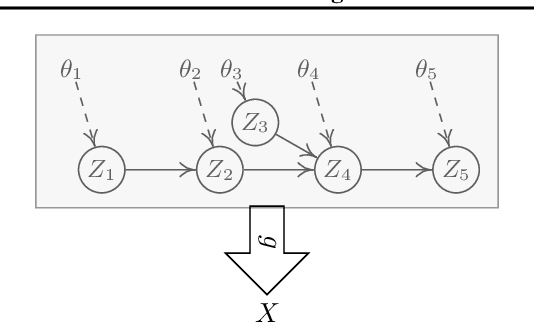
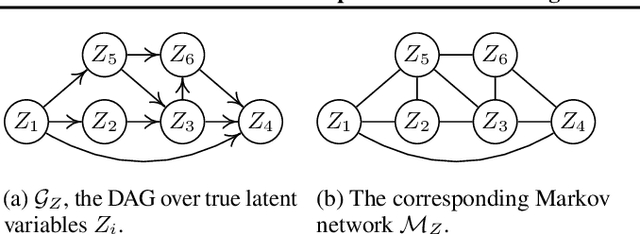


Abstract:In many problems, the measured variables (e.g., image pixels) are just mathematical functions of the hidden causal variables (e.g., the underlying concepts or objects). For the purpose of making predictions in changing environments or making proper changes to the system, it is helpful to recover the hidden causal variables $Z_i$ and their causal relations represented by graph $\mathcal{G}_Z$. This problem has recently been known as causal representation learning. This paper is concerned with a general, completely nonparametric setting of causal representation learning from multiple distributions (arising from heterogeneous data or nonstationary time series), without assuming hard interventions behind distribution changes. We aim to develop general solutions in this fundamental case; as a by product, this helps see the unique benefit offered by other assumptions such as parametric causal models or hard interventions. We show that under the sparsity constraint on the recovered graph over the latent variables and suitable sufficient change conditions on the causal influences, interestingly, one can recover the moralized graph of the underlying directed acyclic graph, and the recovered latent variables and their relations are related to the underlying causal model in a specific, nontrivial way. In some cases, each latent variable can even be recovered up to component-wise transformations. Experimental results verify our theoretical claims.
DreamInpainter: Text-Guided Subject-Driven Image Inpainting with Diffusion Models
Dec 05, 2023


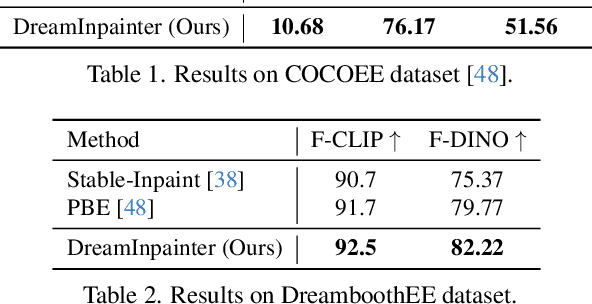
Abstract:This study introduces Text-Guided Subject-Driven Image Inpainting, a novel task that combines text and exemplar images for image inpainting. While both text and exemplar images have been used independently in previous efforts, their combined utilization remains unexplored. Simultaneously accommodating both conditions poses a significant challenge due to the inherent balance required between editability and subject fidelity. To tackle this challenge, we propose a two-step approach DreamInpainter. First, we compute dense subject features to ensure accurate subject replication. Then, we employ a discriminative token selection module to eliminate redundant subject details, preserving the subject's identity while allowing changes according to other conditions such as mask shape and text prompts. Additionally, we introduce a decoupling regularization technique to enhance text control in the presence of exemplar images. Our extensive experiments demonstrate the superior performance of our method in terms of visual quality, identity preservation, and text control, showcasing its effectiveness in the context of text-guided subject-driven image inpainting.
Semi-Implicit Denoising Diffusion Models (SIDDMs)
Jun 23, 2023



Abstract:Despite the proliferation of generative models, achieving fast sampling during inference without compromising sample diversity and quality remains challenging. Existing models such as Denoising Diffusion Probabilistic Models (DDPM) deliver high-quality, diverse samples but are slowed by an inherently high number of iterative steps. The Denoising Diffusion Generative Adversarial Networks (DDGAN) attempted to circumvent this limitation by integrating a GAN model for larger jumps in the diffusion process. However, DDGAN encountered scalability limitations when applied to large datasets. To address these limitations, we introduce a novel approach that tackles the problem by matching implicit and explicit factors. More specifically, our approach involves utilizing an implicit model to match the marginal distributions of noisy data and the explicit conditional distribution of the forward diffusion. This combination allows us to effectively match the joint denoising distributions. Unlike DDPM but similar to DDGAN, we do not enforce a parametric distribution for the reverse step, enabling us to take large steps during inference. Similar to the DDPM but unlike DDGAN, we take advantage of the exact form of the diffusion process. We demonstrate that our proposed method obtains comparable generative performance to diffusion-based models and vastly superior results to models with a small number of sampling steps.
Partial Identifiability for Domain Adaptation
Jun 10, 2023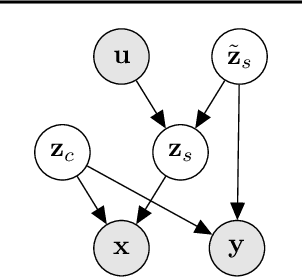

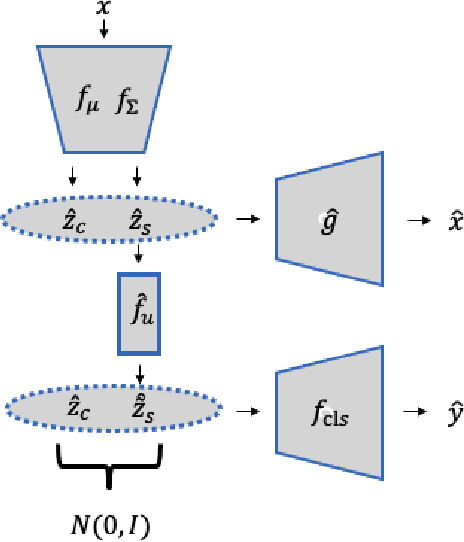

Abstract:Unsupervised domain adaptation is critical to many real-world applications where label information is unavailable in the target domain. In general, without further assumptions, the joint distribution of the features and the label is not identifiable in the target domain. To address this issue, we rely on the property of minimal changes of causal mechanisms across domains to minimize unnecessary influences of distribution shifts. To encode this property, we first formulate the data-generating process using a latent variable model with two partitioned latent subspaces: invariant components whose distributions stay the same across domains and sparse changing components that vary across domains. We further constrain the domain shift to have a restrictive influence on the changing components. Under mild conditions, we show that the latent variables are partially identifiable, from which it follows that the joint distribution of data and labels in the target domain is also identifiable. Given the theoretical insights, we propose a practical domain adaptation framework called iMSDA. Extensive experimental results reveal that iMSDA outperforms state-of-the-art domain adaptation algorithms on benchmark datasets, demonstrating the effectiveness of our framework.
Advancing Counterfactual Inference through Quantile Regression
Jun 09, 2023Abstract:The capacity to address counterfactual "what if" inquiries is crucial for understanding and making use of causal influences. Traditional counterfactual inference usually assumes a structural causal model is available. However, in practice, such a causal model is often unknown and may not be identifiable. This paper aims to perform reliable counterfactual inference based on the (learned) qualitative causal structure and observational data, without a given causal model or even directly estimating conditional distributions. We re-cast counterfactual reasoning as an extended quantile regression problem using neural networks. The approach is statistically more efficient than existing ones, and further makes it possible to develop the generalization ability of the estimated counterfactual outcome to unseen data and provide an upper bound on the generalization error. Experiment results on multiple datasets strongly support our theoretical claims.
SmartBrush: Text and Shape Guided Object Inpainting with Diffusion Model
Dec 09, 2022



Abstract:Generic image inpainting aims to complete a corrupted image by borrowing surrounding information, which barely generates novel content. By contrast, multi-modal inpainting provides more flexible and useful controls on the inpainted content, \eg, a text prompt can be used to describe an object with richer attributes, and a mask can be used to constrain the shape of the inpainted object rather than being only considered as a missing area. We propose a new diffusion-based model named SmartBrush for completing a missing region with an object using both text and shape-guidance. While previous work such as DALLE-2 and Stable Diffusion can do text-guided inapinting they do not support shape guidance and tend to modify background texture surrounding the generated object. Our model incorporates both text and shape guidance with precision control. To preserve the background better, we propose a novel training and sampling strategy by augmenting the diffusion U-net with object-mask prediction. Lastly, we introduce a multi-task training strategy by jointly training inpainting with text-to-image generation to leverage more training data. We conduct extensive experiments showing that our model outperforms all baselines in terms of visual quality, mask controllability, and background preservation.
Adversarial Consistency for Single Domain Generalization in Medical Image Segmentation
Jun 29, 2022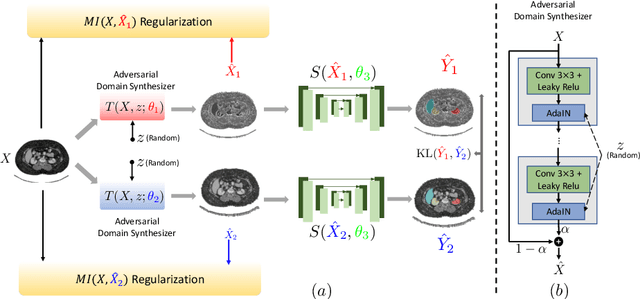



Abstract:An organ segmentation method that can generalize to unseen contrasts and scanner settings can significantly reduce the need for retraining of deep learning models. Domain Generalization (DG) aims to achieve this goal. However, most DG methods for segmentation require training data from multiple domains during training. We propose a novel adversarial domain generalization method for organ segmentation trained on data from a \emph{single} domain. We synthesize the new domains via learning an adversarial domain synthesizer (ADS) and presume that the synthetic domains cover a large enough area of plausible distributions so that unseen domains can be interpolated from synthetic domains. We propose a mutual information regularizer to enforce the semantic consistency between images from the synthetic domains, which can be estimated by patch-level contrastive learning. We evaluate our method for various organ segmentation for unseen modalities, scanning protocols, and scanner sites.
 Add to Chrome
Add to Chrome Add to Firefox
Add to Firefox Add to Edge
Add to Edge